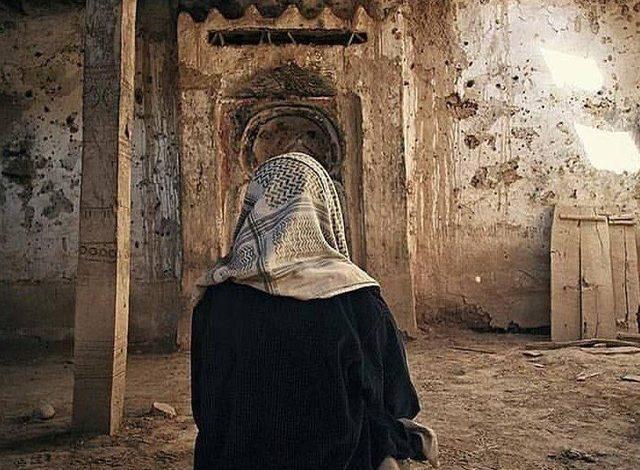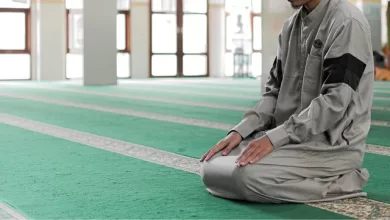
QUESTION
THE DIFFERENCE BETWEEN THE SITTING OF THE FOURTH RAKA’AH AND THE SECOND RAKA’AH
” Assalamualaikum ya admin, please I want you to enlighten us on the sitting at the last rakah of four rakah and two rakah. Is their any difference between them?”
ANSWER
Wa alaykum Salām Warahmatullāh Wabarakātuh.
Alhamdulillāh!
Know, may Allāh be merciful to us and to you,
That there are three positions for sitting that has been discussed by the Ulamā in Salāt.
The first is known as ‘Al-Ifrāsh’, and it is for the Believer to sit, making straight and standing his right foot, while spreading his left foot and sitting upon it
This is Sahih in the Hadīth of Wā’il Ibn Hujr – radiyallāhu ‘anhu – and upon it Imām Abū Hanīfah – rahimahullāh – based his position,
Holding that the Ifrāsh should be the sitting position in the both sittings whether the Salāt is two Raka’āt or four Raka’āt.
The Second is known as ‘At-Tawarruk’ and it is for the Musallī to sit making his right foot stand straight, to fold his left leg at the knee, placing the left foot under the right tigh and his buttocks on the ground.
This is a Sahih Hadīth from ‘Abdullah Ibn ‘Umar – radiyallāhu ‘anhumā – as recorded by Imām Mālik in the Muwattā, Imām Al-Bukhārī, and Abū Dāwud.
Thus the position held by Mālik was that this position is the position preferred to be used for all the sittings. Whether its a two raka’āt, three Raka’āt or four Raka’āt Salah.
The third Sitting position is known as Al-Iq’ā’a
And it is for the Musallī to sit on his heels making his feet straight both of them.
This Hadīth is Sahih from the Hadīth of ‘Abdullāh Ibn ‘Abbās radiyallāhu ‘anhumā as was recorded by Imām Muslim in his Sahih.
Imām Ash-Shāfi’ī – rahimahullāh – explained, as was mentioned by An-Nawawī in his Sharh of Sahih Muslim that it was Sunnah to practice the Iq’ā’a in the sitting between two Sujuds.
He (An-Nawawī) said Qādī ‘Iyyād said;
“It has been recorded from some of the Sahābah and the Salaf that they practiced it.”_
As for the differences in the Sitting positions, we have mentioned in the above
that the position of Imām Abū Hanīfah was the _Ifrāsh_ in all Sittings whether two Raka’āt, three Raka’āt or four Raka’āt Salāt.
That the position of Imām Mālik was the Tawarruk__ in all sittings whether the first or the second sittings.
The position held by Imām Ash-Shāfi’ī – rahimahullāh – is that the _Ifrāsh_ be practiced in the first sitting while the _Tawarruk_ is practiced in the Second Sitting of any Salāt.
He based this on the Hadīth that was recorded by Imām Al-Bukhārī in the Sahih and upon which there is agreement on its authenticity.
…from Abū Humayd As-Sā’idī who mentioned that when the Rasūl – salallāhu alayhi wasallam – sat after the first two raka’āt, he sat on his spread left foot and make straight and standing his right foot ( _Al-Ifrāsh_) and that when he sat at the last Raka’a, he sat on the ground resting his left foot toward the front, making his right foot standing and straight ( Tawarruk)
Imām At-Tabarī – rahimahullāh – and others held that the Musalli is free to use any of the two positions he so chooses.
The strongest position is that of Imām Ash-Shāfi’ī – rahimahullāh
Imām Ahmad – rahimahullāh – agreed with Ash-Shāfi’ī on this
Then you would ask What of Salātu As-Subh or any Salāt with just two Raka’āt?
We say, and help comes from Allāh Alone,
That Ash-Shāfi’ī and Ahmad differed on this.
While Ash-Shāfi’ī – rahimahullāh – held that the Tawarruk is to be done at every last Raka’a, that would mean that every Salāt with Two Raka’āt will have the Tawarruk as its sitting position
Ahmad Ibn Hanbal posited that the Tawarruk is to be done at the Last Raka’ah for only any Salāt that has more than two Raka’āt.
This means that for Witr, any Two Raka’āt Salāt, and for the Second Raka’ah of Maghrib, the _Ifrāsh_, not the Tawarruk is to be practiced.
And the position of Imām Ahmad is stronger than that of Ash-Shāfi’ī here because the Hadīth of Abū Humayd from which reference is drawn was specific to the last Raka’āh and the Salāt was for that with more two Raka’āt
Likewise, the Hadīth of Wā’il Ibn Hujr implied this.
We hope your question has been answered.
If further clarification is needed, we shall provide further explanations Allāh willing
Bārakallāhu fīkum.
QUESTION
IF A DEAD PREGNANT MOTHER IS BURRIED WITHOUT BRINGING OUT THE FETUS, WON’T THAT MEAN THAT THE CHILD WILL BE OPPOSING THE QIBLAH?
” But wont the baby be backing qiblah inside the mother? Salam alaykum”
ANSWER
Alhamdulillāh.
In this case, only the mother is considered and the Child is not considered to have been born.
We have explained that the Ulamā among our Predecessors were very careful about this matter generally and some of them did not agree that the woman be operated to get out the child, that is even if the baby was suspected to be living.
What then do you think would be the case when both of them are considered dead?
Know also that Allāh does not task the Ummah with what is beyond it.
This is not of the matters about which the Ummah would need to go an extent out of worry.
We shall stop here for the week and seek Allāh’s help for a continuation of the answers
Bārakallāhu fīkum.
We shall stop here for the week and seek Allāh’s help for a continuation of the answers.
Jazākumullāhu Khayran
Assalāmu Alaykum Warahmatullāh Wabarakātuh.
16 Jumâdal Âkhir 1439H
(04/03/2018)
📮 *IslamNode*
🌿🌿🌿🌿🌿🌿🌿🌿🌿




